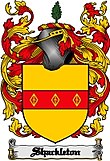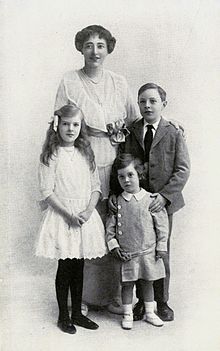Ernest Shackleton
![]()
This article is about the British polar explorer. For the research ship named after him, see Ernest Shackleton (ship).
Sir Ernest Henry Shackleton [ˈɜɻnɛst ˈhɛnɻi ˈʃækəltən] CVO, OBE (Mil.), LL.D, OLH (b. 15 February 1874 in Kilkea, County Kildare, Ireland; † 5. January 1922 in Grytviken, South Georgia) was a British polar explorer of Irish descent and one of the outstanding figures of the so-called "Golden Age of Antarctic Exploration". He participated in four Antarctic expeditions, serving as expedition leader on three of them.
Shackleton's first Antarctic experience was as third officer on the Discovery expedition led by Robert Falcon Scott, from which he was sent home by the expedition leader in 1903 because of a fitness for duty that he disputed.
Determined to erase this blemish, Shackleton returned to Antarctica in 1908 as leader of the Nimrod Expedition. In January 1909, he and three companions set a new record for the closest approach to either of the Earth's geographic poles before turning back at 88°23′S and still 180 km from the South Pole. For this achievement, Shackleton was knighted by King Edward VII.
After the Norwegian Roald Amundsen conquered the South Pole in 1911, Shackleton shifted his attention to crossing the Antarctic continent from coast to coast across the geographical South Pole. But he also failed with this voyage of exploration, known as the Endurance Expedition. The expedition ship sank in the Weddell Sea after being crushed by pack ice. Through an adventurous rescue operation, for which Shackleton is far better known than for his scientific contributions to Antarctic research, he was able to save all expedition members from death.
In 1921, the Quest expedition took him to Antarctic waters for the last time. Even before the actual start of the expedition, Shackleton died of a heart attack in Grytviken on South Georgia and was buried there at the request of his wife.
Away from his explorations, Shackleton's life was restless and unfulfilling. In search of ways to achieve fame and fortune as quickly as possible, he failed with numerous ventures. By the end of his life, Shackleton was heavily in debt. Although he was celebrated as a hero in his obituary by the press, his name, unlike that of his rival Scott, was soon forgotten for a long time. It was not until the turn of the millennium that Shackleton was rediscovered as an exemplary leader who was able to motivate his subordinates to extraordinary achievements in extreme situations.
Origin
Ernest Shackleton was born at Kilkea House, an estate near the village of Athy, the second of ten children of landowner Henry Shackleton (1847-1920) and his wife Henrietta Letitia Sophia (née Gavan, 1845-1929). Closely related to his later life is the fact that the day after his birth, HMS Challenger became the first ship to cross the Arctic Circle with additional mechanical propulsion. Shackleton's paternal ancestors, whose lineage can be traced back to the 13th century, were Quakers from the northern English county of Yorkshire who had been living in Ireland since 1720. There is a distant relationship to the English navigator Martin Frobisher. Shackleton's only brother Francis (called Frank, 1876-1941) was suspected in 1907 to have been involved in the theft of the Irish crown jewels.
The motto of the Shackleton family, whose name is derived from that of a hamlet near the Yorkshire village of Heptonstall, is "Fortitudine Vincimus" (in English: "by endurance we conquer", in German: "Durch Ausdauer zum Sieg"). The family coat of arms, which has existed since about the year 1600, bears three golden clasps on a red background.
Attempts have often been made to infer Shackleton's qualities and traits from his origins, but according to his biographers Margery and James Fisher, this is inaccurate or at best a truncated account. "Shackleton's courage and fighting spirit were no more typically northern English than his charm and fondness for poetry were typically Irish. A study of his background provides a background, but it cannot explain it."

Family coat of arms
Return to civilian life (1903-1907).
Shackleton left Antarctica aboard the Morning on 2 March 1903, having previously tried in vain to persuade his subordinate Charles Reginald Ford (1880-1972) to return home in his place so that he could take over his post as purser aboard the Discovery. After a short recuperation leave in New Zealand, he sailed back to England after stopovers in San Francisco and New York, arriving in June 1903. There his arrival as the first returnee of the expedition was already eagerly awaited. The Admiralty needed first-hand information to make further arrangements for the rescue of the men trapped by ice on Ross Island. With Markham's agreement, Shackleton accepted a temporary position to outfit and load the second rescue ship, the Terra Nova, but declined the offer to return to Antarctica as first officer. He took particular satisfaction, however, in the fact that an Admiralty doctor had declared him fit for duty. Instead, he helped outfit the Argentine corvette Uruguay to rescue the distressed men of the Nordenskjöld expedition.
Shackleton's attempt to obtain permanent employment in the Royal Navy failed, despite the intercession of Markham and William Huggins, president of the Royal Society.
In the autumn of 1903, Shackleton worked as a journalist and co-editor of the Royal Magazine, founded in 1898 by the publisher Sir Arthur Pearson (1866-1921), but ended this unfulfilling activity after only a few weeks. After a lecture tour on the Discovery expedition to Dundee and Aberdeen, he was offered, with the support of his friend Hugh Robert Mill (1861-1950), the recently vacant post of secretary and treasurer of the Royal Scottish Geographical Society (RSGS), which he took up on 14 January 1904. His marriage on 9 April of the same year to Emily Dorman (1868-1936), whom he had known since 1897, also brought private happiness. In February 1905 Shackleton's first son Raymond (1905-1960) was born, and in December 1906 his only daughter Cecily (1906-1957) was born.
In February 1906, Shackleton, who was completely inexperienced in business matters, got involved in a dubious speculative deal for the transport of Russian troops from Vladivostok to the Baltic Sea, which, however, did not materialize. In addition, he tried unsuccessfully to gain a foothold in politics in the 1906 House of Commons election as a Liberal Unionist candidate in Dundee. Eventually the industrialist William Beardmore made him secretary of a commission concerned with the design of new gas engines. His job was to woo Beardmore's clients and keep his professional colleagues in London and Glasgow happy.
Despite this financially secure employment, Shackleton made no secret of his ambition to return to Antarctica as leader of his own expedition. Beardmore was prepared to support him in this venture with a guarantee of £7000 (2009: €615,000). However, other investors failed to materialise for the time being. Nevertheless, Shackleton dared to present his plans to the Royal Geographical Society in February 1907. A detailed publication followed shortly afterwards in the Geographical Journal.

Shackleton's wife Emily with their children Cecily, Edward and Raymond (l. to r.)
Questions and Answers
Q: Who was Sir Ernest Henry Shackleton?
A: Sir Ernest Henry Shackleton was a polar explorer who led three British expeditions to the Antarctic and was one of the principal figures of the "Heroic Age of Antarctic Exploration".
Q: Where was Shackleton born?
A: Shackleton was born in County Kildare, Ireland.
Q: Where did he move when he was ten?
A: When he was ten, Shackleton and his Anglo-Irish family moved to Sydenham in suburban London.
Q: What expedition did Shackleton take part in before leading his own?
A: Before leading his own expedition, Shackleton took part in Captain Robert Falcon Scott's Discovery Expedition from 1901-1904 as third officer.
Q: What accomplishment earned him a knighthood?
A: His accomplishment that earned him a knighthood from Edward VII on his return home was reaching the furthest South latitude anyone had reached at 88° 23' S, 97 geographical miles (112 statute miles, 180 km) from the South Pole.
Q: How close to the pole did this achievement bring him?
A: This achievement brought him 112 statute miles or 180 km away from the South Pole.
Search within the encyclopedia
